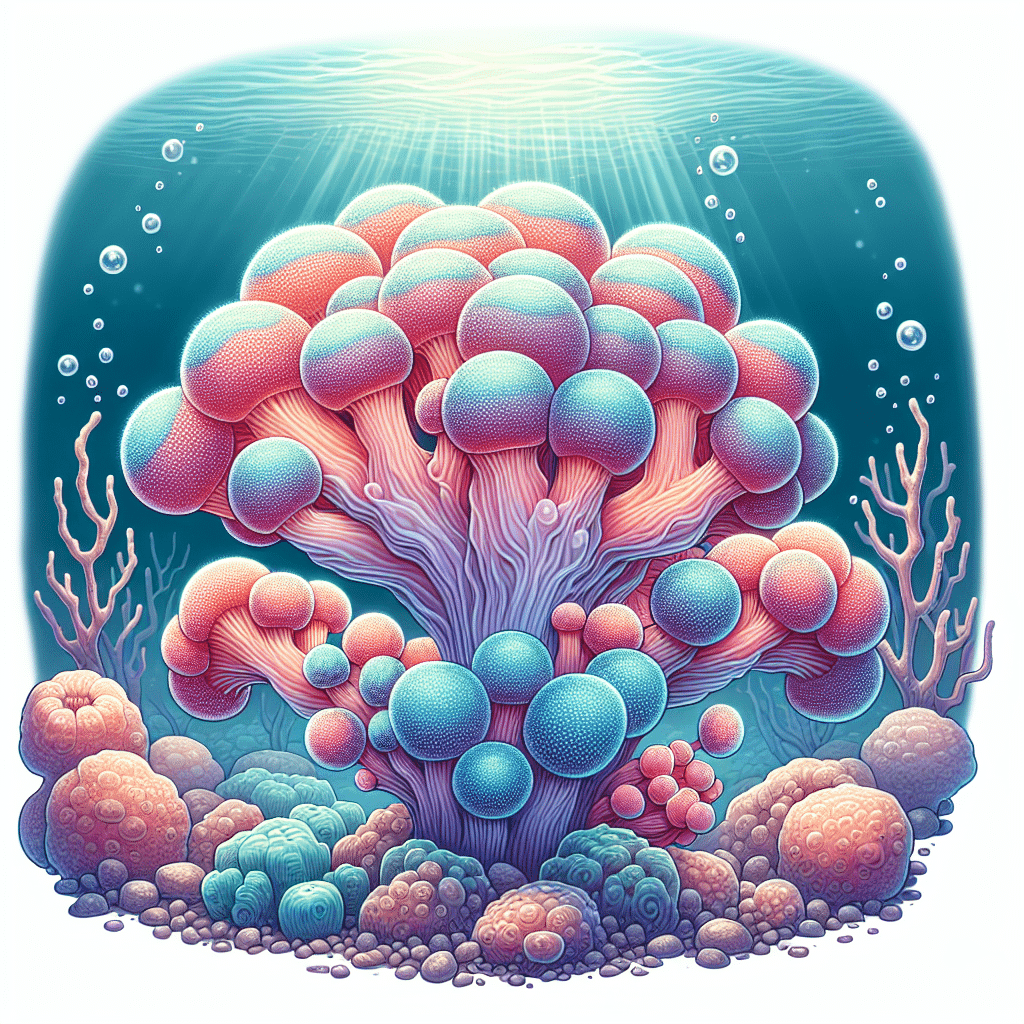Understanding Ricordea Mushrooms
Ricordea mushrooms are fascinating additions to any reef tank. Their unique characteristics and growth patterns make them a popular choice among hobbyists.
Growth Rate and Characteristics
Ricordea mushrooms typically grow at a moderate pace, with many reefers, including myself, reporting noticeable growth within just a few months of acquiring them (Reef2Reef). These mushrooms are relatively easy to care for, making them suitable for both beginners and experienced aquarists.
One interesting aspect of Ricordea mushrooms is their structure. Ricordea florida, for example, is a coral without a skeleton, sharing some anatomical similarities with corals of the order Scleractinia. They feature a small, cylindrical body that can reach up to 7.5 cm in diameter. The basal end resembles a flat disk, functioning as a foot, while the apical end acts as the oral disk with one or more mouths. Their tentacles contain cnidocytes, which have a lower stinging ability compared to most corals, making them less aggressive.
Native Varieties and Coloration
There are two main species of Ricordea mushrooms: Ricordea florida and Ricordea yuma. Ricordea florida is native to Florida and the Caribbean, known for its distinctive bubbly appearance and vibrant colors. This species can be found in a range of hues, including purple, orange, green, blue, and yellow. The coloration is influenced by various factors such as depth, temperature, and environmental conditions (Wikipedia). The rarest color is pink, while the most valuable variety is the rainbow Ricordea, which displays complex color patterns (Fragbox).
On the other hand, Ricordea yuma is found in the Indo-Pacific region. This species also showcases a variety of colors, but it typically has a more robust appearance compared to its Florida counterpart.
Here’s a quick comparison of the two species:
| Species | Native Region | Color Variations | Notable Features |
|---|---|---|---|
| Ricordea florida | Florida & Caribbean | Purple, orange, green, blue, yellow, pink | Bubbly appearance, lower sting |
| Ricordea yuma | Indo-Pacific region | Various colors | More robust appearance |
Ricordea mushrooms can be a stunning and dynamic addition to my reef tank, and understanding their growth and color variations helps me create a thriving environment for them. For more information on other types of corals, feel free to check out articles on mushroom coral and brain coral.
Care and Placement of Ricordea Mushrooms
Taking care of Ricordea mushrooms can be a fun and rewarding experience. These vibrant corals are relatively easy to maintain, but there are a few key factors to consider for their optimal growth.
Tank Preferences
Ricordea mushrooms thrive in various tank sizes, including nano and pico tanks. They prefer high nutrient water and can tolerate elevated nitrate and phosphate levels. In my experience, it’s best to place them lower in the aquarium. They should not be positioned too close to other corals because of their powerful sting, which can harm neighboring species (Fragbox).
| Tank Type | Size Range |
|---|---|
| Nano Tank | 5 – 20 gallons |
| Pico Tank | Less than 5 gallons |
Lighting and Water Quality
When it comes to lighting, Ricordea mushrooms enjoy medium to high light levels. In the wild, they typically grow in shallow waters where they receive ample light. Strong blue LED lighting works well for these corals. I have found that maintaining good water quality is essential, especially for Ricordea yuma, which is more sensitive compared to Ricordea florida.
| Lighting Type | Intensity |
|---|---|
| LED Lighting | High (strong blue spectrum) |
| T5 Lighting | Medium to High |
Feeding and Placement
While Ricordea mushrooms respond to fine foods, they generally prefer meatier options. I like to feed them small pieces about half the size of a mysis shrimp. Additionally, adding amino acids can support their health. It’s important to note that they thrive in low to medium water flow. Too much flow can prevent them from fully extending and may cause them to blow around in the tank (Tidal Gardens).
| Feeding Type | Recommended Size |
|---|---|
| Mysis Shrimp | 0.5 size |
| Amino Acids | N/A |
By keeping these care and placement tips in mind, I’ve found my Ricordea mushrooms to flourish and add beautiful color to my reef tank. For more information on different coral species, check out our articles on corals and specific types like mushroom coral or brain coral.
Differentiating Ricordea Species
When diving into the world of ricordea mushrooms, it’s essential to know the differences between the two primary species: Ricordea Florida and Ricordea Yuma. Each has its unique characteristics and care requirements, which can significantly affect how I manage them in my reef tank.
Ricordea Florida
Ricordea Florida is primarily found in the Caribbean region. This species is generally more robust and adaptable compared to its counterpart, making it a popular choice for hobbyists like me. Ricordea Florida tends to thrive in various water conditions and is less sensitive to fluctuations in water quality, which makes it easier to keep long-term.
| Feature | Ricordea Florida |
|---|---|
| Native Range | Caribbean |
| Sensitivity to Water | Lower |
| Care Level | Easier |
Ricordea Yuma
On the other hand, Ricordea Yuma originates from the Indo-Pacific region. This species is known for being more sensitive to water quality and parameters, which can make it a bit tricky for me to maintain over time. Ricordea Yuma exhibits distinct reproductive characteristics; it is likely a broadcast-spawning species. Females release eggs through the mouth, and these eggs are positively buoyant but disintegrate within a few hours, showing no signs of fertilization or embryonic development.
| Feature | Ricordea Yuma |
|---|---|
| Native Range | Indo-Pacific |
| Sensitivity to Water | Higher |
| Care Level | More Difficult |
| Reproduction | Broadcast-spawning |
Ricordea Yuma polyps have distinct sexes, with females exhibiting orange eggs and males showing white spermaries. Unlike Ricordea Florida, this species does not display sexual dimorphism or sequential hermaphroditism (Springer Link).
By understanding these differences, I can better tailor my care routines for each species, ensuring that both Ricordea Florida and Ricordea Yuma thrive in my reef tank. For more information on various coral types, check out our sections on corals and other fascinating species like torch coral and mushroom coral.
Coral Diseases and Maintenance
Disease Susceptibility
Ricordea mushrooms are generally considered beginner corals and are easy to care for. They don’t show high susceptibility to common coral diseases such as STN (Slow Tissue Necrosis) or RTN (Rapid Tissue Necrosis) (Reef Chasers). This is largely due to the fact that they lack a calcium carbonate skeleton, which means they don’t require the extreme maintenance often needed for other corals regarding calcium and alkalinity levels.
While they are resilient, it’s important to keep an eye out for conditions that could stress them. Maintaining stable water parameters and avoiding sudden changes in the environment will help keep your Ricordea mushrooms healthy.
Maintenance Tips
Caring for Ricordea mushrooms involves a few straightforward steps to ensure they thrive in your reef tank. Here are some essential maintenance tips:
| Maintenance Aspect | Recommendation |
|---|---|
| Water Quality | Keep water parameters stable and clean. Regular water changes help maintain quality. |
| Detritus Management | Ensure to keep detritus clear from around the mushrooms to prevent stress. |
| Water Flow | Moderate water flow is ideal. Too much flow may cause the mushrooms to detach from their plug or fitting. |
| Feeding | Supplement their diet with foods designed for filter-feeding invertebrates, such as microplankton. Ricordea mushrooms filter-feed on nutrients from the water column. |
| Aggressiveness | Be cautious about their aggressive nature as they can contribute to allelopathy when growing in numbers. Running activated carbon can help manage this (Reef Chasers). |
By following these tips, I can ensure that my Ricordea mushrooms remain healthy and vibrant in my reef tank. Their ease of care makes them a good choice for both beginners and experienced hobbyists looking to add some colorful anemone-like corals to their aquascape.
Reproduction of Ricordea Mushrooms
Understanding how Ricordea mushrooms reproduce is essential for anyone looking to care for these fascinating corals. They have two main methods of reproduction: asexual and sexual.
Asexual Reproduction
Asexual reproduction in Ricordea mushrooms primarily occurs through a process called budding. In this method, new polyps develop from the existing ones, eventually detaching to form new individuals. This process can be quite rapid, allowing for a healthy colony to expand efficiently.
One of the great things about asexual reproduction is that it doesn’t require both male and female polyps. Instead, a single polyp can produce more of itself, which is perfect for hobbyists who want to grow their collection without needing to find mates for their corals.
Sexual Reproduction
On the other hand, sexual reproduction in Ricordea mushrooms is a bit more complex. For instance, Ricordea yuma has been observed to be gonochoric, meaning it has distinct male and female sexes. Females produce orange eggs, while males generate white sperm cells (Springer Link).
They are likely broadcast-spawning species, which means they release their gametes into the water column for external fertilization. During spawning events, females release a small number of eggs at irregular intervals, mostly at night, while males release their sperm. Unfortunately, the eggs are positively buoyant and may disintegrate within hours without showing signs of fertilization. This adds a level of unpredictability to their reproductive success.
To summarize, Ricordea mushrooms can reproduce both asexually through budding and sexually through gamete release. Understanding these processes is crucial for anyone interested in the care and propagation of these beautiful corals in a reef tank.
Pricing and Availability
Aquaculture and Growth
I find that Ricordea mushrooms are readily available through aquaculture, which makes them a great choice for coral enthusiasts like me. They grow at a decent rate and are fairly easy to care for, contributing to their overall accessibility. Their growth in controlled environments helps ensure that hobbyists can find healthy specimens without putting too much strain on natural reefs.
| Growth Rate | Care Level | Availability |
|---|---|---|
| Decent | Easy | High |
Unique color morphs can significantly impact pricing. For example, rare and unique coloration can fetch higher prices than more common varieties. This means that if I’m looking for something a bit more special, I might want to keep an eye on coloration trends and availability.
Pricing Factors
The pricing of Ricordea mushrooms can vary based on several factors. Generally, I’ve observed that prices range from low to moderate, depending on the specific color morph of the specimen.
| Color Morph | Price Range |
|---|---|
| Basic Varieties | $20 – $50 |
| Rare Varieties | $50 – $150+ |
The specific color of the mushroom can make a big difference; rare colorations may be priced considerably higher than the more common ones. As a hobbyist, I always check for reputable sources when purchasing to ensure I’m getting a quality specimen that fits within my budget.
For those interested in expanding their coral collection, Ricordea mushrooms make a colorful and manageable addition to any reef tank, especially when considering their moderate care requirements and appealing aesthetics. If you’re also into other coral options, you might want to check out mushroom coral or zoanthids for more variety in your tank.
Environmental Factors for Ricordea Mushrooms
Caring for Ricordea mushrooms involves understanding their environmental needs, including temperature range and water flow. These factors play a significant role in their growth and overall health.
Temperature Range
Ricordea mushrooms thrive in a specific temperature range. The ideal temperature is around 82°F (28°C), but they can adapt to slightly lower or higher temperatures. They can survive in temperatures as low as 77°F and as high as 84°F (Reef Chasers).
| Temperature | Description |
|---|---|
| 77°F (25°C) | Minimum survival temperature |
| 82°F (28°C) | Ideal thriving temperature |
| 84°F (29°C) | Maximum survival temperature |
Maintaining the right temperature is essential, as fluctuations can stress the mushrooms, impacting their health and growth.
Water Flow and Food
Water flow is another crucial factor for Ricordea mushrooms. They prefer low to medium water flow in the aquarium. Excessive flow can prevent them from fully extending their bodies or may cause them to blow around in the tank (Tidal Gardens).
| Water Flow | Description |
|---|---|
| Low | Ideal for Ricordea mushrooms to extend fully |
| Medium | Acceptable, but should not be too strong |
| High | Not suitable; can cause stress and instability |
In terms of feeding, Ricordea mushrooms filter-feed on nutrients from the water column and maintain a symbiotic relationship with photosynthetic algae called zooxanthellae. This relationship provides many nutrients. However, it’s also advisable to supplement their diet with additional foods like microplankton or specialized foods designed for filter-feeding invertebrates (Reef Chasers).
They tend to respond better to meatier foods, with optimal sizes being about half the size of a mysis shrimp. Adding amino acids can also support their overall health (Tidal Gardens).
By ensuring the right temperature and water flow, along with proper feeding, I can help my Ricordea mushrooms thrive in my reef tank environment.
Health Benefits of Ricordea Mushrooms
Ricordea mushrooms are not only visually striking additions to a reef tank but may also offer several health benefits. As a hobbyist, it’s fascinating to explore their nutritional and medicinal properties.
Nutritional Value
While specific nutritional data for Ricordea mushrooms is limited, it’s known that many types of edible mushrooms provide essential nutrients. These often include proteins, vitamins (such as B vitamins), and minerals (like selenium and potassium). The polysaccharides found in various mushrooms are notable for their ability to carry biological information and exhibit numerous beneficial activities, including antioxidant and anti-inflammatory properties NCBI.
| Nutrient | Amount per 100g (approx.) |
|---|---|
| Protein | 2.2g |
| Fiber | 1.0g |
| Vitamin D | Varies |
| Selenium | 9.3µg |
Medicinal Properties
The medicinal properties of Ricordea mushrooms are worth noting, especially in the context of their potential health benefits. Like other medicinal mushrooms, they may contain bioactive compounds that exhibit various properties such as antitumor, immunomodulatory, and antioxidant effects. These activities depend on the specific structural features of the polysaccharides and other compounds present NCBI.
For example, compounds found in mushrooms like Ganoderma lucidum (reishi) have shown anticancer and immunomodulatory effects, while others like Lentinula edodes (shiitake) may promote immune response and inhibit tumor growth. The bioactive components in Ricordea mushrooms could potentially provide similar benefits if further researched.
In summary, Ricordea mushrooms not only enhance the aesthetic appeal of your reef tank, but they may also contribute positively to health through their nutritional and medicinal properties. If you’re interested in learning more about other corals and their benefits, check out articles on corals, mushroom coral, or even brain coral.



